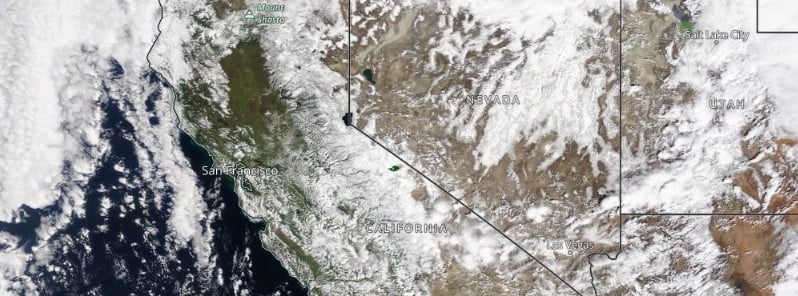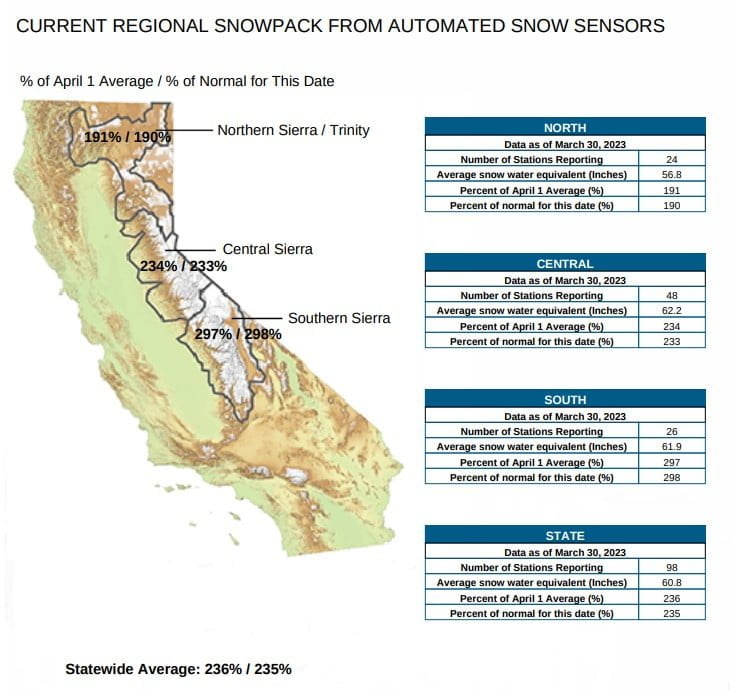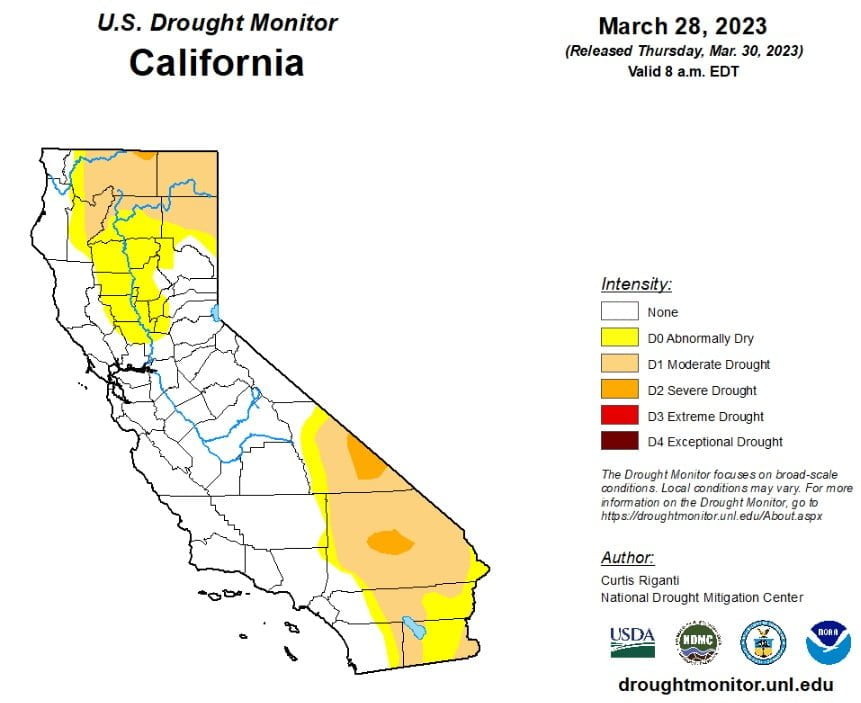Massive snowfall results in California’s largest snowpack on record

17 atmospheric rivers and several non-atmospheric-river storms since December 2022 pushed California’s snowpack to its largest level in recorded history, surpassing the previous record set in 1982-1983. In addition, the state’s drought conditions have improved significantly since the start of the water year, with severe to exceptional drought conditions now covering only 6.99% of the area, down from 93% just one year ago.
California now boasts its largest snowpack in recorded history, with a statewide snowpack of 236% of the peak normal and nearly 300% in the Southern Sierra. As of March 30, 2023, the California Department of Water Resources reports that the statewide average snow water content stands at 154.4 cm (60.8 inches), breaking the previous record of 153.2 cm (60.3 inches) set in May 1983.
The latest in the series of storms that started in December 2022 brought an additional 0.3 to 0.6 m (1 to 2 feet) of snow to the Sierra Nevada, culminating in the record-breaking snowpack on March 30, 2023. The previous record was held by the 1982/83 season with 234% (central Sierra) and 298% (southern Sierra) of normal snowpack levels.
The Northern Sierra region experienced comparatively less snow, with snow water content at 190% of normal, still trailing the levels recorded in 1982-83.
Unprecedented snowfall at ski resorts in the Sierra Nevada led to extraordinary heights, in some cases even burying chairlifts. Mammoth Mountain announced its snowiest season on record with 1 783 cm (702 inches) at its Main Lodge, surpassing the previous record of 1 698 cm (668.5 inches). At the mountain’s summit, Mammoth measured 2 232 cm (879 inches). The National Weather Service’s gridded snowfall analysis suggests that some totals exceeded 2 286 cm (900 inches) in the snowiest areas of the Sierra.
The Central Sierra Snow Lab, located near Lake Tahoe, recorded a seasonal total of 1 813 cm (713.8 inches) after the latest storm, making it the second most on record.
Although snowpack typically peaks around this time of the year, resorts in the Sierra can expect an additional 0.9 to 1.8 m (3 to 6 feet) of snow on average through the end of the season in May or June, suggesting that these totals may continue to climb and set new records.

Looking at the latest data provided by the US Drought Monitor, we can see that the state’s drought conditions have improved significantly since the start of the water year (September 27, 2022), with severe to exceptional drought conditions covering only 1.95% of the area, as of March 28. In contrast, one year ago, severe to exceptional drought conditions covered over 93% of the area.
| Week | Date | None | D0-D4 | D1-D4 | D2-D4 | D3-D4 | D4 | DSCI |
|---|---|---|---|---|---|---|---|---|
| Current | March 28, 2023 | 55.34 | 44.66 | 28.11 | 1.95 | 0.00 | 0.00 | 75 |
| Last Week | March 21, 2023 | 48.51 | 51.49 | 35.88 | 8.49 | 0.00 | 0.00 | 96 |
| 3 Months Ago | December 27, 2022 | 0.00 | 100.00 | 97.94 | 80.56 | 35.50 | 7.16 | 321 |
| Start of Calendar Year | December 27, 2022 | 0.00 | 100.00 | 97.94 | 80.56 | 35.50 | 7.16 | 321 |
| Start of Water Year | September 27, 2022 | 0.00 | 100.00 | 99.76 | 94.01 | 40.91 | 16.57 | 351 |
| One Year Ago | March 29, 2022 | 0.00 | 100.00 | 100.00 | 93.65 | 40.25 | 0.00 | 334 |
The Drought Severity Index (DSCI) for California is currently at 75, indicating a relatively mild drought. This is a significant improvement compared to one year ago when the DSCI was at 334, indicating severe and extensive drought conditions.
The severe drought conditions that California experienced one year ago had significant implications for the state’s economy, environment, and communities. The lack of rainfall and snowpack led to reduced water supplies for agriculture and drinking water, increased wildfire risks, and negative impacts on natural ecosystems.

References:
1 CDEC – California Department of Water Resources – March 30, 2023
2 California’s snowpack soars to record high after 17 atmospheric rivers – The Washington Post – March 30, 2023
3 California drought monitor – March 30, 2023
Featured image credit: NASA Terra/MODIS. Acquired on March 31, 2023

Commenting rules and guidelines
We value the thoughts and opinions of our readers and welcome healthy discussions on our website. In order to maintain a respectful and positive community, we ask that all commenters follow these rules.